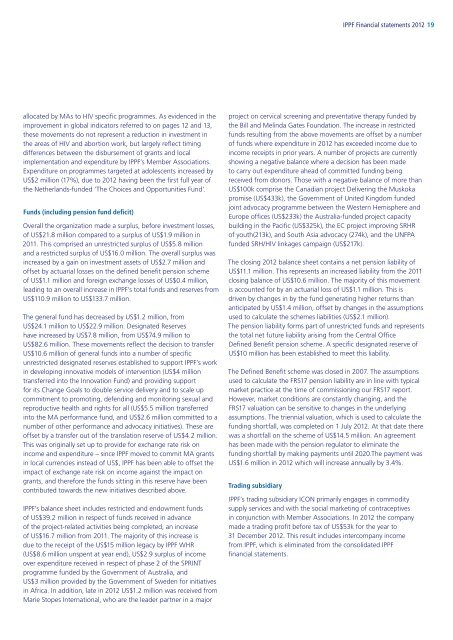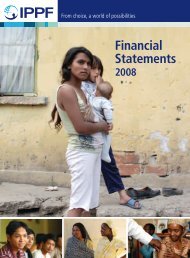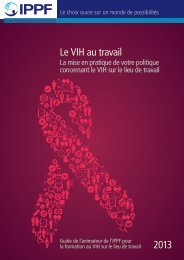Financial statements - International Planned Parenthood Federation
Financial statements - International Planned Parenthood Federation
Financial statements - International Planned Parenthood Federation
Create successful ePaper yourself
Turn your PDF publications into a flip-book with our unique Google optimized e-Paper software.
IPPF <strong>Financial</strong> <strong>statements</strong> 2012 19<br />
allocated by MAs to HIV specific programmes. As evidenced in the<br />
improvement in global indicators referred to on pages 12 and 13,<br />
these movements do not represent a reduction in investment in<br />
the areas of HIV and abortion work, but largely reflect timing<br />
differences between the disbursement of grants and local<br />
implementation and expenditure by IPPF’s Member Associations.<br />
Expenditure on programmes targeted at adolescents increased by<br />
US$2 million (17%), due to 2012 having been the first full year of<br />
the Netherlands-funded ‘The Choices and Opportunities Fund’.<br />
Funds (including pension fund deficit)<br />
Overall the organization made a surplus, before investment losses,<br />
of US$21.8 million compared to a surplus of US$1.9 million in<br />
2011. This comprised an unrestricted surplus of US$5.8 million<br />
and a restricted surplus of US$16.0 million. The overall surplus was<br />
increased by a gain on investment assets of US$2.7 million and<br />
offset by actuarial losses on the defined benefit pension scheme<br />
of US$1.1 million and foreign exchange losses of US$0.4 million,<br />
leading to an overall increase in IPPF’s total funds and reserves from<br />
US$110.9 million to US$133.7 million.<br />
The general fund has decreased by US$1.2 million, from<br />
US$24.1 million to US$22.9 million. Designated Reserves<br />
have increased by US$7.8 million, from US$74.9 million to<br />
US$82.6 million. These movements reflect the decision to transfer<br />
US$10.6 million of general funds into a number of specific<br />
unrestricted designated reserves established to support IPPF’s work<br />
in developing innovative models of intervention (US$4 million<br />
transferred into the Innovation Fund) and providing support<br />
for its Change Goals to double service delivery and to scale up<br />
commitment to promoting, defending and monitoring sexual and<br />
reproductive health and rights for all (US$5.5 million transferred<br />
into the MA performance fund, and US$2.6 million committed to a<br />
number of other performance and advocacy initiatives). These are<br />
offset by a transfer out of the translation reserve of US$4.2 million.<br />
This was originally set up to provide for exchange rate risk on<br />
income and expenditure – since IPPF moved to commit MA grants<br />
in local currencies instead of US$, IPPF has been able to offset the<br />
impact of exchange rate risk on income against the impact on<br />
grants, and therefore the funds sitting in this reserve have been<br />
contributed towards the new initiatives described above.<br />
IPPF’s balance sheet includes restricted and endowment funds<br />
of US$39.2 million in respect of funds received in advance<br />
of the project-related activities being completed, an increase<br />
of US$16.7 million from 2011. The majority of this increase is<br />
due to the receipt of the US$15 million legacy by IPPF WHR<br />
(US$8.6 million unspent at year end), US$2.9 surplus of income<br />
over expenditure received in respect of phase 2 of the SPRINT<br />
programme funded by the Government of Australia, and<br />
US$3 million provided by the Government of Sweden for initiatives<br />
in Africa. In addition, late in 2012 US$1.2 million was received from<br />
Marie Stopes <strong>International</strong>, who are the leader partner in a major<br />
project on cervical screening and preventative therapy funded by<br />
the Bill and Melinda Gates Foundation. The increase in restricted<br />
funds resulting from the above movements are offset by a number<br />
of funds where expenditure in 2012 has exceeded income due to<br />
income receipts in prior years. A number of projects are currently<br />
showing a negative balance where a decision has been made<br />
to carry out expenditure ahead of committed funding being<br />
received from donors. Those with a negative balance of more than<br />
US$100k comprise the Canadian project Delivering the Muskoka<br />
promise (US$433k), the Government of United Kingdom funded<br />
joint advocacy programme between the Western Hemisphere and<br />
Europe offices (US$233k) the Australia-funded project capacity<br />
building in the Pacific (US$325k), the EC project improving SRHR<br />
of youth(213k), and South Asia advocacy (274k), and the UNFPA<br />
funded SRH/HIV linkages campaign (US$217k).<br />
The closing 2012 balance sheet contains a net pension liability of<br />
US$11.1 million. This represents an increased liability from the 2011<br />
closing balance of US$10.6 million. The majority of this movement<br />
is accounted for by an actuarial loss of US$1.1 million. This is<br />
driven by changes in by the fund generating higher returns than<br />
anticipated by US$1.4 million, offset by changes in the assumptions<br />
used to calculate the schemes liabilities (US$2.1 million).<br />
The pension liability forms part of unrestricted funds and represents<br />
the total net future liability arising from the Central Office<br />
Defined Benefit pension scheme. A specific designated reserve of<br />
US$10 million has been established to meet this liability.<br />
The Defined Benefit scheme was closed in 2007. The assumptions<br />
used to calculate the FRS17 pension liability are in line with typical<br />
market practice at the time of commissioning our FRS17 report.<br />
However, market conditions are constantly changing, and the<br />
FRS17 valuation can be sensitive to changes in the underlying<br />
assumptions. The triennial valuation, which is used to calculate the<br />
funding shortfall, was completed on 1 July 2012. At that date there<br />
was a shortfall on the scheme of US$14.5 million. An agreement<br />
has been made with the pension regulator to eliminate the<br />
funding shortfall by making payments until 2020.The payment was<br />
US$1.6 million in 2012 which will increase annually by 3.4%.<br />
Trading subsidiary<br />
IPPF’s trading subsidiary ICON primarily engages in commodity<br />
supply services and with the social marketing of contraceptives<br />
in conjunction with Member Associations. In 2012 the company<br />
made a trading profit before tax of US$53k for the year to<br />
31 December 2012. This result includes intercompany income<br />
from IPPF, which is eliminated from the consolidated IPPF<br />
financial <strong>statements</strong>.








